
Van Buren County is a county located in the U.S. state of Iowa. As of the 2020 census the population was 7,203, making it the state's tenth-least populous county. The county seat is Keosauqua, which contains the oldest continuously operational courthouse in the state of Iowa, and second oldest in the United States.
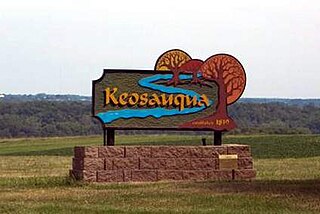
Keosauqua is a city in Van Buren County, Iowa, United States. The population was 936 at the time of the 2020 census. It is the county seat of Van Buren County.
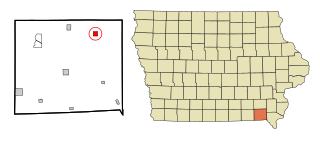
Stockport is a city in Van Buren County, Iowa, United States. The population was 272 at the time of the 2020 census.
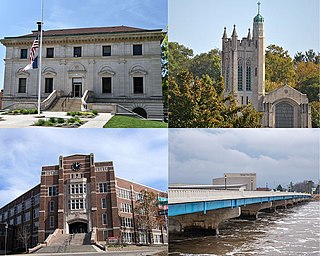
Ottumwa is a city in and the county seat of Wapello County, Iowa, United States. The population was 25,529 at the time of the 2020 U.S. Census. Located in the state's southeastern section, the city is split into northern and southern halves by the Des Moines River. Ottumwa serves as a major economic, commercial, and cultural hub for the Southeastern Iowa region.

George Grover Wright was a pioneer lawyer, Iowa Supreme Court justice, law professor, and Republican United States Senator from Iowa.

Iowa Highway 1 (Iowa 1) is a state highway in the U.S. state of Iowa that extends from Keosauqua to Anamosa. It travels nearly 120 miles (190 km), mainly through rich farmland and small communities. Iowa 1 provides an important link to Iowa City and the University of Iowa as it passes through campus. Portions of the route today date back to the late 1830s, when Martin Van Buren was president, making Iowa 1 one of the oldest routes in the state, pre-dating the current primary highway system by nearly eighty years. The highway was seriously damaged by the Cedar River in the Iowa flood of 2008, which closed the highway for seven weeks.

Shimek State Forest is an Iowa state forest maintained by the Iowa Department of Natural Resources. Its five units are strung along the Des Moines River a few miles above its confluence with the Upper Mississippi River in Lee and Van Buren Counties in the southeast corner of Iowa. Its 9,148 acres (37 km2) contain one of the largest remaining contiguous forests in the state with large stands of mixed oak-hickory forest with about 1,000 acres of planted pine.

Lake Sugema [Pronounced sōō•jē’•mə](+40° 41' 22.85", -91° 59' 39.01") is a man-made 574-acre (2.32 km2) lake 3 miles (4.8 km) southwest of Keosauqua, Van Buren County, in southeast Iowa, United States. It is located south of the Des Moines River, west of State Highway 1 and north of State Highway 2.

The Hotel Blackhawk is an eleven-story brick and terra cotta building located in Downtown Davenport, Iowa, United States. It is a Marriott Autograph Collection property.

Hoyt Sherman Place, the home of Hoyt Sherman, was built in 1877 and is located in Des Moines, Iowa.
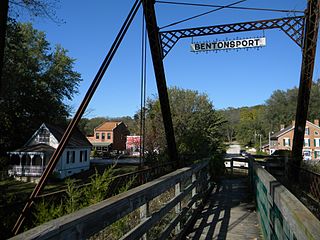
Bentonsport, a village on the Des Moines River near Keosauqua, in Van Buren County, Iowa, was recognized in 1972 for being very little changed since its historic heyday as a thriving steamboat port in the mid-1800s. A 35-acre (14 ha) historic district covering 16 original blocks in the historic center of the village was then approved for listing on the National Register of Historic Places. The district also included waterfront property and the village's historic wagon bridge across the river to the village of Vernon.

The Van Buren County Courthouse located in Keosauqua, Iowa, United States, was built in 1843. It was listed on the National Register of Historic Places in 1977 as a part of the County Courthouses in Iowa Thematic Resource. It is the only building the county has used as its courthouse, and it is the oldest courthouse in Iowa. In 1845 the courthouse served as the location for a trial resulting in the first death penalty in Iowa history.
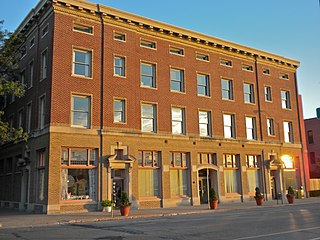
The Northwestern Hotel is an historic building located in the East Village of Des Moines, Iowa, United States. It was listed on the National Register of Historic Places in 1984. In 2017 it was included as a contributing property in the East Des Moines Industrial Historic District.

Voltaire Paine Twombly was a Union veteran of the American Civil War and a recipient of the Medal of Honor. He received the Medal of Honor for his actions during the Battle of Fort Donelson on February 15, 1862, when he picked up and carried his regiment's national colors after three other members of his regiment were killed or incapacitated by Confederate fire while attempting to secure the flag. Twombly also participated in a number of other engagements in the Civil War, including the Siege of Corinth and Sherman's March to the Sea.

Lacey-Keosauqua State Park is located southwest of Keosauqua, Iowa, United States. The park is located along the Des Moines River in Van Buren County. First dedicated in 1921, it is the largest state park in size in Iowa. In 1990, three areas were named nationally recognized historic districts and listed on the National Register of Historic Places.

The Kilbourn Bridge is located just south of Kilbourn, Iowa, United States. It carried traffic on Lark Avenue over the Des Moines River for 855 feet (261 m). In 1890 the Van Buren County Board of Supervisors contracted with the Western Bridge Company of Chicago to build a bridge at the Kilbourn ferry crossing. It was destroyed in a flood in 1903. The Board of Supervisors put off replacing the bridge until 1907, and then all the proposals came over the $20,000 limit. The following the year they removed the limit. The six-span bridge was designed by the Iowa State Highway Commission (ISHC), and built by the Ottumwa Supply and Construction Company of Ottumwa, Iowa. It was the first large-scale engineering project undertaken by the newly formed ISHC. The Kilbourn Bridge was listed on the National Register of Historic Places in 1998.

The Voltaire Twombley Building is a historic building located in Keosauqua, Iowa, United States. The two-story structure is a good example of 19th-century vernacular commercial design constructed in limestone. it is the largest example of stone construction that remains in Van Buren County. While it was built in the 1870s, it is more reminiscent of similar buildings constructed in the 1840s and 1850s. The only thing that differentiates these rectangular, front gable structures from a house or a school is the first floor storefront. Keosauqua had several stone commercial buildings at one time, but now they are all brick but this one. The building is associated with Voltaire P. Twombly, who was awarded the Medal of Honor for bravery at the Battle of Fort Donelson during the American Civil War. He operated a dry goods and grocery business in this building beginning in 1876. It was listed on the National Register of Historic Places in 1993.

Des Moines River Locks No. 5 and No. 7, also known as the Bonaparte and Keosauqua Locks, comprise a discontinuous historic site located along the Des Moines River in Van Buren County, Iowa, United States. Lock No. 5 is located in a riverfront park in Bonaparte, and lock No. 7 is located near Keosauqua. The locks are the only structures that are known to exist for the Des Moines River Improvement Project. Steamboats were the primary means of transportation into the interior of Iowa, but the river was only navigable at certain times of the year and that made the shipping season too short and unpredictable. In 1846 the Iowa Legislature conceived a plan to build a lock and dam system along the Des Moines River to make it navigable from the Mississippi River to the city of Des Moines. These two locks and a third at Bentonsport, non extant, were the only locks of the 28 planned locks and dams that were completed. The project ended in 1858 because it was mismanaged, and the Keokuk and Des Moines River Railroad was being developed to cover the same territory at the same time. Two dams had also been completed, but they have since been removed. Even though the project was never completed, navigation was possible via the locks as far upriver as Keosauqua.
Aunty Green Hotel is a historic building located in Bonaparte, Iowa, United States. The hotel was built by John Green in 1844. His wife Mary continued to operate the hotel for many years after his death, and that what gave the business its name. It was the second hotel established in town, and it is believed to be the first brick building constructed in Bonaparte. Other businesses that have been housed in this building include a photography studio, doctor's offices, the first local telephone exchange, a creamery and a gas station. The Van Buren County Historical Association rescued the structure from demolition. It is currently owned by the Bonaparte Historical Society and houses the Auntie Green Museum and the public library.
Van Buren Community School District was a school district headquartered in Keosauqua, Iowa.





















